Architectural Insights: Designing Efficient Multi-Layered Caching With Instagram Example
DZone
FEBRUARY 27, 2024
Leveraging this hierarchical structure can significantly reduce latency and improve overall performance.
This site uses cookies to improve your experience. By viewing our content, you are accepting the use of cookies. To help us insure we adhere to various privacy regulations, please select your country/region of residence. If you do not select a country we will assume you are from the United States. View our privacy policy and terms of use.

DZone
FEBRUARY 27, 2024
Leveraging this hierarchical structure can significantly reduce latency and improve overall performance.

DZone
JUNE 22, 2023
It involves a combination of techniques and best practices aimed at reducing latency, improving user experience, and increasing the overall efficiency of the system. API performance optimization is the process of improving the speed, scalability, and reliability of APIs.
This site is protected by reCAPTCHA and the Google Privacy Policy and Terms of Service apply.
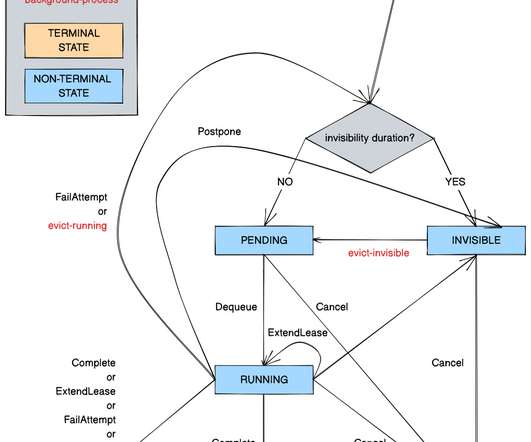
The Netflix TechBlog
SEPTEMBER 29, 2022
Timestone: Netflix’s High-Throughput, Low-Latency Priority Queueing System with Built-in Support for Non-Parallelizable Workloads by Kostas Christidis Introduction Timestone is a high-throughput, low-latency priority queueing system we built in-house to support the needs of Cosmos , our media encoding platform. Over the past 2.5

Scalegrid
JANUARY 25, 2024
Key Takeaways Critical performance indicators such as latency, CPU usage, memory utilization, hit rate, and number of connected clients/slaves/evictions must be monitored to maintain Redis’s high throughput and low latency capabilities. These essential data points heavily influence both stability and efficiency within the system.

Scalegrid
MARCH 28, 2024
Redis Data Types and Structures The design of Redis’s data structures emphasizes versatility. Snapshots provide point-in-time captures of the dataset, which are efficient for recovery on startup. It is designed to cache plain text values, offering fast read and write access to frequently accessed data.

Dynatrace
SEPTEMBER 13, 2023
This is a set of best practices and guidelines that help you design and operate reliable, secure, efficient, cost-effective, and sustainable systems in the cloud. The framework comprises six pillars: Operational Excellence, Security, Reliability, Performance Efficiency, Cost Optimization, and Sustainability.

Dynatrace
JANUARY 31, 2024
Model observability provides visibility into resource consumption and operation costs, aiding in optimization and ensuring the most efficient use of available resources. Observing AI models Running AI models at scale can be resource-intensive. However, organizations must consider which use cases will bring them the biggest ROI.

Dynatrace
JANUARY 17, 2024
As organizations turn to artificial intelligence for operational efficiency and product innovation in multicloud environments, they have to balance the benefits with skyrocketing costs associated with AI. The good news is AI-augmented applications can make organizations massively more productive and efficient. Use containerization.
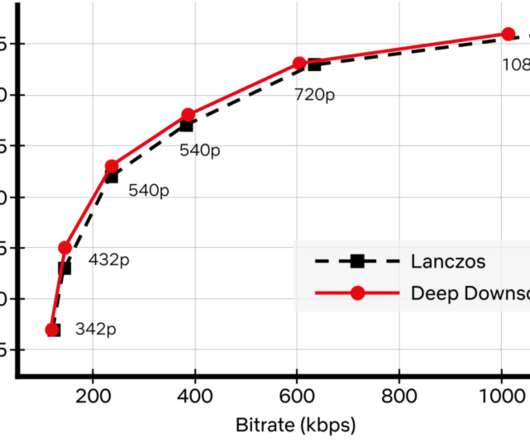
The Netflix TechBlog
NOVEMBER 17, 2022
While conventional video codecs remain prevalent, NN-based video encoding tools are flourishing and closing the performance gap in terms of compression efficiency. We employed an adaptive network design that is applicable to the wide variety of resolutions we use for encoding. How do we apply neural networks at scale efficiently?
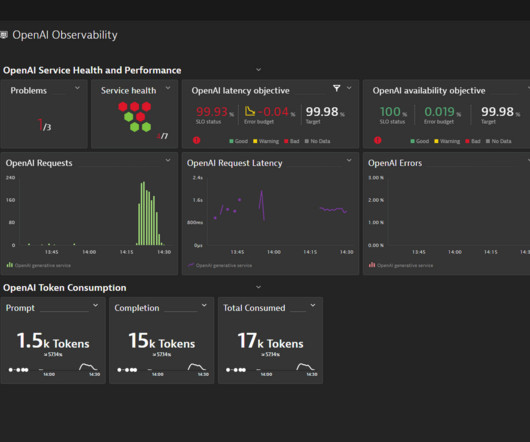
Dynatrace
JUNE 7, 2023
A typical design pattern is the use of a semantic search over a domain-specific knowledge base, like internal documentation, to provide the required context in the prompt. With these latency, reliability, and cost measurements in place, your operations team can now define their own OpenAI dashboards and SLOs.
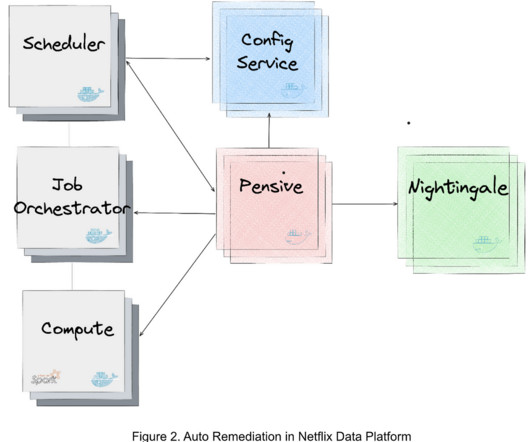
The Netflix TechBlog
MARCH 4, 2024
We have deployed Auto Remediation in production for handling memory configuration errors and unclassified errors of Spark jobs and observed its efficiency and effectiveness (e.g., For efficient error handling, Netflix developed an error classification service, called Pensive, which leverages a rule-based classifier for error classification.

Scalegrid
JANUARY 8, 2024
This article delves into the specifics of how AI optimizes cloud efficiency, ensures scalability, and reinforces security, providing a glimpse at its transformative role without giving away extensive details. Using AI for Enhanced Cloud Operations The integration of AI in cloud computing is enhancing operational efficiency in several ways.

Scalegrid
FEBRUARY 8, 2024
Their design emphasizes increasing availability by spreading out files among different nodes or servers — this approach significantly reduces risks associated with losing or corrupting data due to node failure. Variations within these storage systems are called distributed file systems.

The Netflix TechBlog
MARCH 7, 2024
Since its inception , Metaflow has been designed to provide a human-friendly API for building data and ML (and today AI) applications and deploying them in our production infrastructure frictionlessly. In other cases, it is more convenient to share the results via a low-latency API.

Dynatrace
JULY 24, 2023
In the world of DevOps and SRE, DevOps automation answers the undeniable need for efficiency and scalability. This evolution in automation, referred to as answer-driven automation, empowers teams to address complex issues in real time, optimize workflows, and enhance overall operational efficiency.

Scalegrid
MARCH 22, 2024
They can also bolster uptime and limit latency issues or potential downtimes. Choosing the Right Cloud Services Choosing the right cloud services is crucial in developing an efficient multi cloud strategy. They simplify how you orchestrate everything across the diverse ecosystem of cloud services.

Percona
APRIL 17, 2023
The CFQ works well for many general use cases but lacks latency guarantees. The deadline excels at latency-sensitive use cases ( like databases ), and noop is closer to no schedule at all. On the other hand, MongoDB schema design takes a document-oriented approach. Two other schedulers are deadline and noop.

Dynatrace
OCTOBER 4, 2022
While data lakes and data warehousing architectures are commonly used modes for storing and analyzing data, a data lakehouse is an efficient third way to store and analyze data that unifies the two architectures while preserving the benefits of both. Data lakehouses deliver the query response with minimal latency. Data warehouses.

Scalegrid
JANUARY 12, 2024
This article analyzes cloud workloads, delving into their forms, functions, and how they influence the cost and efficiency of your cloud infrastructure. Simply put, it’s the set of computational tasks that cloud systems perform, such as hosting databases, enabling collaboration tools, or running compute-intensive algorithms.

Scalegrid
MARCH 14, 2024
In practice, a hybrid cloud operates by melding resources and services from multiple computing environments, which necessitates effective coordination, orchestration, and integration to work efficiently. Tailoring resource allocation efficiently ensures faster application performance in alignment with organizational demands.

Percona
MARCH 20, 2023
When designing an architecture, many components need to be considered before deciding on the best solution. In this scenario, it is also crucial to be efficient in resource utilization and scaling with frugality. Let us take a look also the latency: Here the situation starts to be a little bit more complicated.

IO River
NOVEMBER 2, 2023
A content delivery network (CDN) is a distributed network of servers strategically located across multiple geographical locations to deliver web content to end users more efficiently. The Four Pillars of CDN DesignCDN architecture can be broken down into several building blocks, known as the Four Pillars of CDN Design.

ACM Sigarch
MAY 31, 2023
Heterogeneous and Composable Memory (HCM) offers a feasible solution for terabyte- or petabyte-scale systems, addressing the performance and efficiency demands of emerging big-data applications. even lowered the latency by introducing a multi-headed device that collapses switches and memory controllers. The recently announced CXL3.0

IO River
NOVEMBER 2, 2023
â€A content delivery network (CDN) is a distributed network of servers strategically located across multiple geographical locations to deliver web content to end users more efficiently. When an edge server goes down, end users in the affected region may experience an increase in latency for that specific location.

The Netflix TechBlog
OCTOBER 26, 2021
False negatives are closely related to the statistical concept of power , which gives the probability of a true positive given the experimental design and a true effect of a specific size. As a result, if the test treatment results in a small reduction in the latency metric, it’s hard to successfully identify?

Dynatrace
APRIL 5, 2021
The 2014 launch of AWS Lambda marked a milestone in how organizations use cloud services to deliver their applications more efficiently, by running functions at the edge of the cloud without the cost and operational overhead of on-premises servers. AWS continues to improve how it handles latency issues. Dynatrace news.

Percona
MARCH 29, 2023
As the amount of data grows, the need for efficient data compression becomes increasingly important to save storage space, reduce I/O overhead, and improve query performance. Snappy compression is designed to be fast and efficient regarding memory usage, making it a good fit for MongoDB workloads.

The Netflix TechBlog
SEPTEMBER 8, 2020
For each route we migrated, we wanted to make sure we were not introducing any regressions: either in the form of missing (or worse, wrong) data, or by increasing the latency of each endpoint. Being able to canary a new route let us verify latency and error rates were within acceptable limits. This meant that data that was static (e.g.

The Morning Paper
NOVEMBER 10, 2019
It’s been clear for a while that software designed explicitly for the data center environment will increasingly want/need to make different design trade-offs to e.g. general-purpose systems software that you might install on your own machines. The desire for CPU efficiency and lower latencies is easy to understand.

Dynatrace
DECEMBER 15, 2022
ITOps refers to the process of acquiring, designing, deploying, configuring, and maintaining equipment and services that support an organization’s desired business outcomes. This includes response time, accuracy, speed, throughput, uptime, CPU utilization, and latency. Performance. What does IT operations do?

Percona
DECEMBER 11, 2023
A Dedicated Log Volume (DLV) is a specialized storage volume designed to house database transaction logs separately from the volume containing the database tables. This separation aims to streamline transaction write logging, improving efficiency and consistency.

Adrian Cockcroft
JANUARY 20, 2023
Here’s some predictions I’m making: Jack Dongarra’s efforts to highlight the low efficiency of the HPCG benchmark as an issue will influence the next generation of supercomputer architectures to optimize for sparse matrix computations. Jack Dongarra talked about the scores, and pointed out the low efficiency on some important workloads.

Dynatrace
FEBRUARY 24, 2021
As Google’s Ben Treynor explains , “Fundamentally, it’s what happens when you ask a software engineer to design an operations function.” Designating and managing Service Level Objectives (SLOs) as availability targets for a service. Reduced latency. Efficiency. Streamlined change management.

Dynatrace
JANUARY 13, 2022
Analyzing a clinician’s clickstream when using an electronic medical record system to better improve the efficiency of data entry. Providing insight into the service latency to help developers identify poorly performing code. Tracking users’ paths through the conversion funnel and using that data for attributing revenue.

Brendan Gregg
FEBRUARY 28, 2023
My personal opinion is that I don't see a widespread need for more capacity given horizontal scaling and servers that can already exceed 1 Tbyte of DRAM; bandwidth is also helpful, but I'd be concerned about the increased latency for adding a hop to more memory. Ford, et al., “TCP

The Netflix TechBlog
JUNE 4, 2019
Because microprocessors are so fast, computer architecture design has evolved towards adding various levels of caching between compute units and the main memory, in order to hide the latency of bringing the bits to the brains. This avoids thrashing caches too much for B and evens out the pressure on the L3 caches of the machine.

High Scalability
SEPTEMBER 8, 2018
Anna is not only incredibly fast, it’s incredibly efficient and elastic too: an autoscaling, multi-tier, selectively-replicating cloud service. The issue is that Anna is now orders of magnitude more efficient than competing systems, in addition to being orders of magnitude faster. What's changed ?

Dynatrace
JANUARY 18, 2023
This methodology aims to improve software system reliability using several key categories such as availability, performance, latency, efficiency, capacity, and incident response. DevOps is a tactical approach to creating and delivering software designed to close the gap between development and IT operations. What is DevOps?
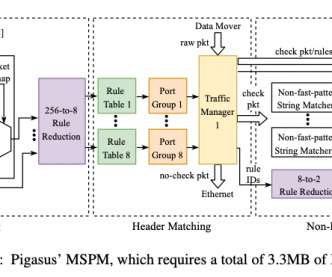
The Morning Paper
NOVEMBER 15, 2020
Improving the efficiency with which we can coordinate work across a collection of units (see the Universal Scalability Law ). With more nodes and more coordination comes more complexity, both in design and operation. This makes the whole system latency sensitive. Increasing the amount of work we can do on a single unit.

The Morning Paper
FEBRUARY 6, 2020
’ Stateless is fine until you need state, at which point the coarse-grained solutions offered by current platforms limit the kinds of application designs that work well. On the Cloudburst design teams’ wish list: A running function’s ‘hot’ data should be kept physically nearby for low-latency access.

Dynatrace
FEBRUARY 2, 2022
service availability with <50ms latency for an application with no revenue impact. To avoid this, start the SLO discussion early in the design process. This can create an unnecessary distraction and steal time away from critical tasks. For example, the IT team of a bank wants to ensure that for a trailing 30-day period there is 99.9%

The Netflix TechBlog
OCTOBER 19, 2020
Now let’s look at how we designed the tracing infrastructure that powers Edgar. If we had an ID for each streaming session then distributed tracing could easily reconstruct session failure by providing service topology, retry and error tags, and latency measurements for all service calls. Storage: don’t break the bank!

Dynatrace
OCTOBER 1, 2021
The goal of observability is to understand what’s happening across all these environments and among the technologies, so you can detect and resolve issues to keep your systems efficient and reliable and your customers happy. The architects and developers who create the software must design it to be observed.
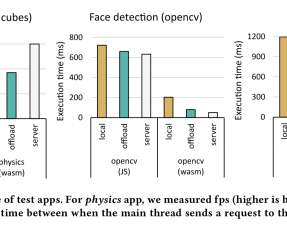
The Morning Paper
JANUARY 30, 2020
Edge servers are the middle ground – more compute power than a mobile device, but with latency of just a few ms. The client MWW combines these estimates with an estimate of the input/output transmission time (latency) to find the worker with the minimum overall execution latency.
Expert insights. Personalized for you.
We have resent the email to
Are you sure you want to cancel your subscriptions?


Let's personalize your content